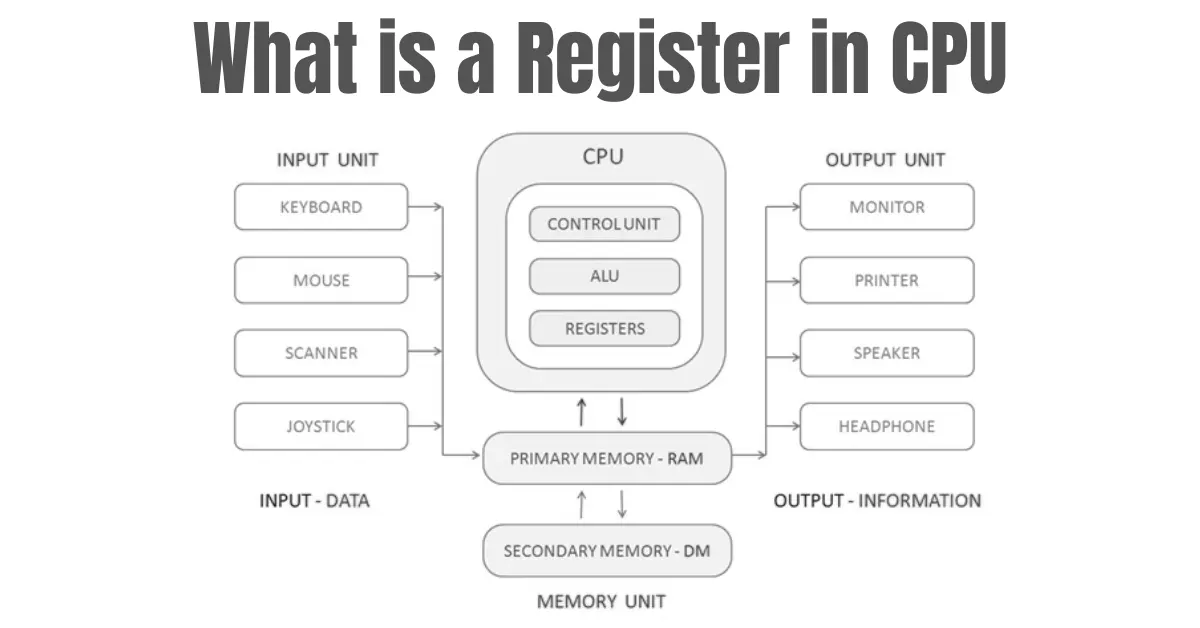- The Evolution of Computer Memory: Why Registers Exist
- So, What Is a Register?
- Real-Life Analogy: Chef Chomu’s Kitchen
- Types of Registers – Not All Are the Same
- Speed Comparison: Register vs RAM vs Cache
- The Role of Registers in a CPU Instruction Cycle
- Why Don’t We Just Use Registers for Everything?
- Registers vs Cache vs RAM – Summing It Up
- Registers in Modern CPUs
- Registers Are the Thoughts of the CPU
- Want to Go Deeper?
- References and Sources
When we talk about computer memory, most people think of RAM. Some might even go a step deeper and mention cache. But buried even further inside your computer’s brain lies something much smaller, much faster, and much more crucial—the register.
Yes, registers are the unsung heroes inside your CPU that work at microsecond (or even nanosecond) speeds. Think of them as tiny high-speed notepads that help the CPU think and act at lightning speed. They don’t store photos or files—but they make sure everything else can.
In this post, we’ll unravel what a register is, why it’s so fast, how it’s different from RAM or cache, and why without registers, your computer would feel like it’s thinking through molasses.
The Evolution of Computer Memory: Why Registers Exist
Let’s start at the root.
Early computers were slow and clunky—not because of weak CPUs, but because of slow memory access. A CPU could calculate faster than it could get the data it needed from memory. That bottleneck created a serious performance issue.
So engineers started thinking: What if we gave the CPU its own ultra-fast memory space—right inside it?
Thus, registers were born.
So, What Is a Register?
A register is a small amount of very fast memory located directly inside the CPU. Unlike RAM (which sits outside the CPU chip), registers are hardwired to the CPU’s control unit and arithmetic logic unit (ALU).
They are used to store:
- Intermediate values during calculations
- Memory addresses to fetch data
- The current instruction being executed
- Flags (tiny bits indicating results like “zero” or “carry”)
In short: Registers are the working memory of the CPU.
Real-Life Analogy: Chef Chomu’s Kitchen
Imagine a chef named Chomu in a high-speed restaurant kitchen.
- The pantry is your RAM. It has all the ingredients, but it takes time to walk back and forth.
- The countertop is the CPU cache—closer and faster.
- But Chomu keeps the most important things right in front of him: a spoon, knife, salt, oil—these are registers.
They’re tiny, they’re few, but they are always within reach—because time matters.
Types of Registers – Not All Are the Same
Registers come in several types, each with a specialized role:
| Register Type | Purpose |
|---|---|
| Accumulator | Holds the result of arithmetic/logic operations |
| Program Counter (PC) | Stores the address of the next instruction |
| Instruction Register (IR) | Holds the current instruction being executed |
| Stack Pointer (SP) | Points to the top of the stack in memory |
| General Purpose Registers | Used for general arithmetic and data movement |
| Flag Registers | Holds condition flags (e.g., zero, carry, sign) |
Speed Comparison: Register vs RAM vs Cache
Here’s where things get serious. Let’s compare access times:
- Register: ~1 nanosecond (or less)
- L1 Cache: ~2-3 nanoseconds
- RAM: ~50-100 nanoseconds
- SSD: ~100,000 nanoseconds
That’s millions of times faster than your SSD.
Registers are at the top of the memory hierarchy. The CPU doesn’t need to “ask” anyone to read or write them—they’re right there, instantly accessible.
The Role of Registers in a CPU Instruction Cycle
Let’s take a single CPU instruction—say, ADD A, B. Here’s what happens under the hood:
- Fetch – The instruction is fetched into the Instruction Register.
- Decode – The control unit decodes what to do: add two numbers.
- Execute – It pulls
AandBfrom registers, performs the addition in the ALU. - Store – The result goes back into a register (usually the accumulator).
No RAM was involved. That entire cycle happened inside the CPU using registers.
Why Don’t We Just Use Registers for Everything?
Excellent question. If registers are so fast, why not use them for everything?
Three reasons:
- Size: Registers are tiny—CPUs typically have 8 to 32 general-purpose registers.
- Cost: Fast memory is expensive to make.
- Power: More registers = more heat and power consumption.
Registers are like premium real estate inside the CPU. You can’t afford to build a mansion on every inch.
Registers vs Cache vs RAM – Summing It Up
| Feature | Registers | Cache | RAM |
|---|---|---|---|
| Speed | Fastest | Very Fast | Fast |
| Size | Smallest (bits) | Small (KBs–MBs) | Large (GBs) |
| Location | Inside CPU | Near CPU | On motherboard |
| Cost | Highest | High | Low |
If this is fascinating, you’ll love our detailed blog on How the CPU Process Really Works, where we break down the processor’s entire journey.
Registers in Modern CPUs
Modern CPUs (Intel, AMD, ARM) use register sets—groups of registers reserved for:
- Integer operations
- Floating point operations
- SIMD/vector operations (like multimedia processing)
In fact, high-performance computing (like gaming or AI) relies heavily on register efficiency.
Also, modern compilers are very smart about using registers. They try to keep as much data in registers as possible because accessing anything else—even cache—is slower.
Registers Are the Thoughts of the CPU
If your CPU is your brain, registers are its short-term thoughts. They’re not memories like RAM or storage like SSD. They are what the CPU is actively thinking right now.
They make computing possible at the speed we experience today. And they do it in silence—quickly, invisibly, brilliantly.
Want to Go Deeper?
You might also like:
- How RAM and Hard Drive Differ – What’s the Real Difference?
- What is a Kernel? Why It’s the Brain of the Operating System



